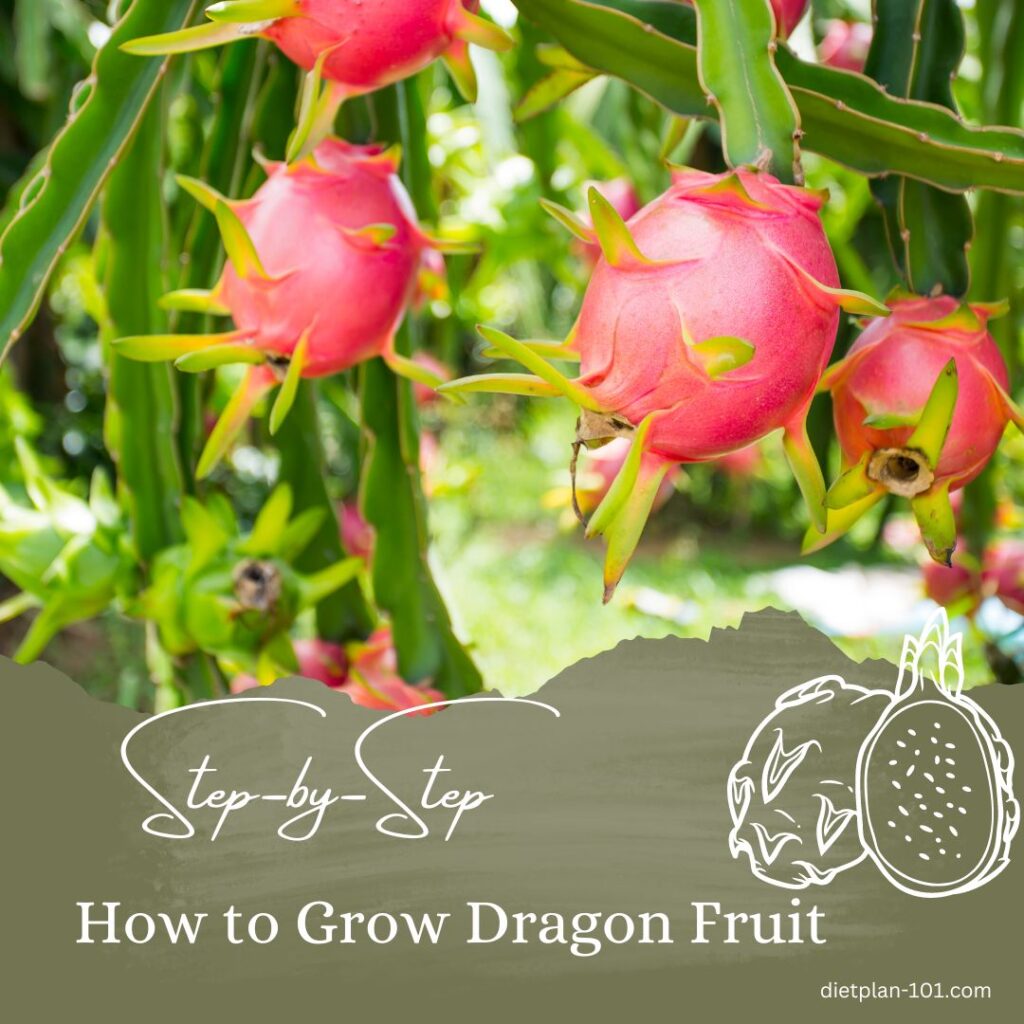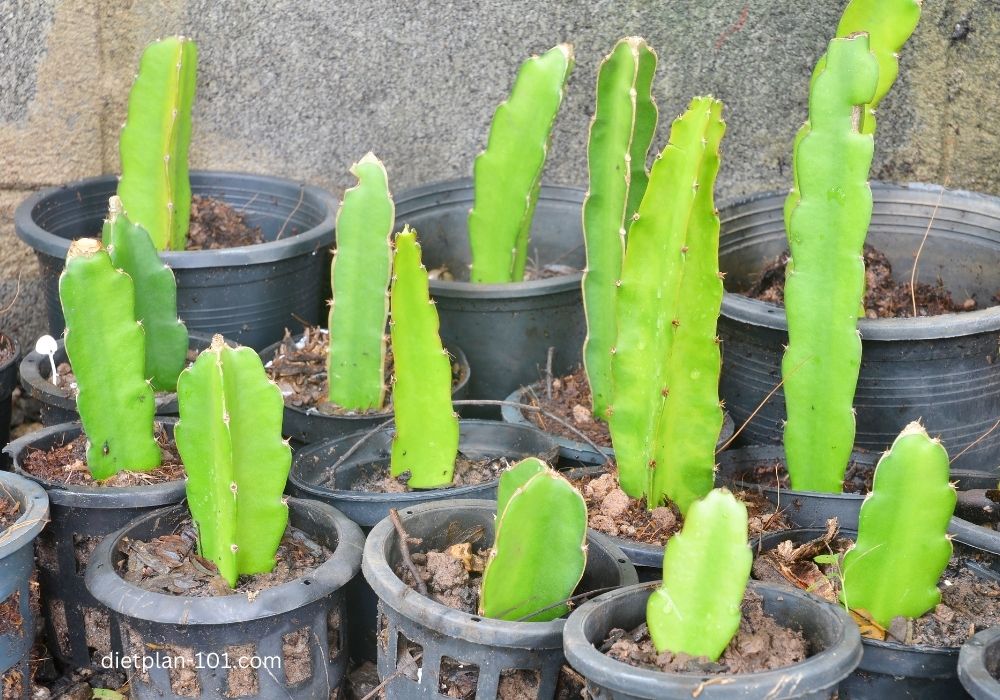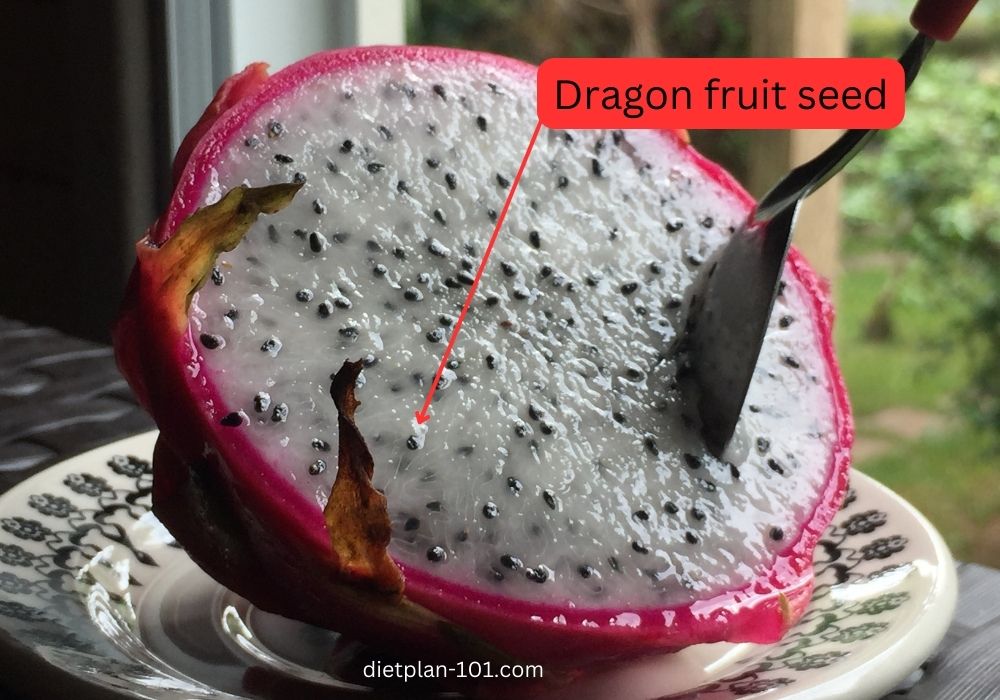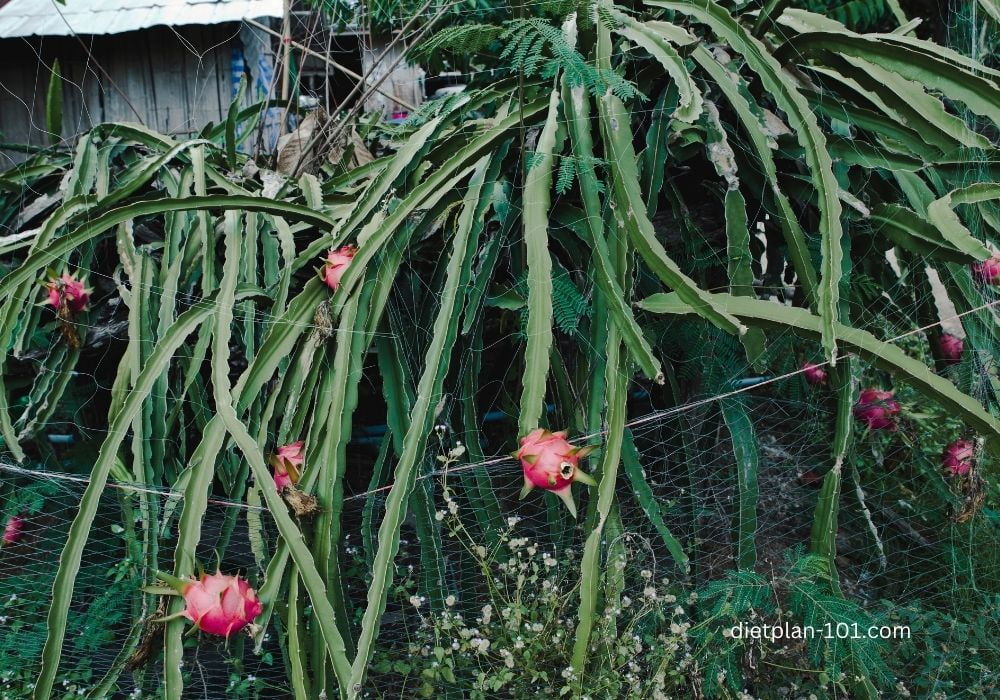Dragon fruit, also known as pitaya or pitahaya, is a stunningly beautiful tropical fruit with a unique appearance and delicious taste. With its numerous health benefits and exotic allure, growing dragon fruit in your own garden is a rewarding experience.
In this step-by-step guide, we’ll walk you through everything you need to know to successfully grow and savor this incredible fruit. So, let’s get started and make your garden the talk of the town!
Table of Contents
Dragon fruit is a night-blooming plant, which means its flowers open and bloom during the night. These flowers, sometimes called “moonflowers,” are large, fragrant, and often last just one night. The reason for this nocturnal blooming behavior is that the dragon fruit plant is pollinated primarily by bats and moths—creatures that are most active at night.
Choosing the right type of dragon fruit variety to grow
Dragon fruit is an exotic gem, and choosing the right variety can make a world of difference! Let me introduce you to the top 3 amazing varieties, each with its own unique charm:
- Hylocereus undatus (White-fleshed dragon fruit): This is the classic choice! Sporting a vibrant pink or red outer skin, it hides a delectably sweet, white flesh peppered with tiny, edible black seeds. If you’re new to dragon fruit, this is a fabulous starting point!
- Hylocereus costaricensis (Red-fleshed dragon fruit): Are you a fan of bolder flavors? With a similar outer appearance to the white-fleshed variety, this type unveils a stunning magenta or red flesh that packs a slightly richer flavor. It’s perfect for those seeking a little extra oomph!
- Hylocereus megalanthus (Yellow-skinned dragon fruit): Looking for something truly unique? This eye-catching variety features a bright yellow outer skin and a mildly sweet, white flesh sprinkled with black seeds. It’s a conversation starter and a taste sensation rolled into one!
When picking your favorite variety to grow, consider your local climate, your taste preferences, and the availability of plant material. But honestly, you can’t go wrong with any of these fantastic options. Choose the one that speaks to you, and get ready for a dragon fruit adventure that’ll leave you craving more!
Here’s a table that provides a comparison of the three main dragon fruit varieties, their characteristics, and their growing conditions.
| Dragon Fruit Variety | Flesh Color | Skin Color | Flavor | Climate | Ease of Growth |
|---|---|---|---|---|---|
| Hylocereus undatus | White | Pink | Mildly sweet, refreshing | Warm, tropical or subtropical | Easy to grow, popular variety |
| Hylocereus costaricensis | Red | Magenta | Sweet, with a hint of tartness | Warm, tropical or subtropical | Slightly more challenging, but rewarding |
| Hylocereus megalanthus | White | Yellow | Sweet and delicate, with crunchy seeds | Warm, tropical or subtropical | More challenging, less common |
With this table, you can quickly compare the three different dragon fruit varieties and choose the one that best suits your preferences and growing conditions.
Planting and propagation
How to grow dragon fruit from cuttings
- Selecting healthy cuttings: To start your dragon fruit journey, make sure you pick cuttings from a mature, healthy plant that’s free of any diseases or pests. Look for branches that are about 10-15 inches long with healthy green growth.
- Preparing cuttings for planting: Let the cut end dry for a few days, forming a callus. This is crucial for successful planting, as it helps prevent rotting and encourages root growth.
- Planting the cuttings: Plant the cuttings in a well-draining soil mix, burying the callused end about 2-3 inches deep. Make sure to position the cutting upright, with the cut end facing down, and provide support if necessary. Remember to keep the soil moist, but not overly wet, and place the cutting in a bright, warm spot. Roots should begin to develop in 2-4 weeks. Your cuttings are now ready to grow!
How to grow dragon fruit from seeds
If you’re fascinated by the prospect of growing your own dragon fruit, here are the steps.
Step 1: Choose a ripe dragon fruit and scoop out the seeds. Give them a good wash to remove any lingering pulp – a clean start is key!
Step 2: Spread the seeds onto a moist paper towel or seedling mix, and gently cover them with more seedling mix or another damp paper towel. Find a cozy, warm spot (around 70-80°F or 21-27°C) with ample light, and keep the seeds consistently moist. In just 10-14 days, you’ll start to see the magic of germination unfold!
Step 3: Once your seedlings reach a few inches in height and flaunt a couple of sets of true leaves, it’s time to give them their own space. Gently transplant them into individual pots, and continue showering them with light, warmth, and just the right amount of moisture
Growing dragon fruit from seeds is a rewarding journey that lets you witness the beauty of nature in action. So why not give it a try and nurture your very own dragon fruit garden? Happy planting!
Best soil and potting requirements for dragon fruit
Soil Type and Composition
- Drainage: Dragon fruit plants require well-draining soil to keep their roots healthy and rot-free. A mixture of potting soil, sand, and perlite or pumice can help promote proper drainage.
- Nutrients: Use a soil mix rich in organic matter, such as compost or aged manure to provide the essential nutrients your plants need for optimal growth.
Potting and Container Options
- Pot size and material: Choose a pot that’s at least 12 inches deep and wide, made from materials like terracotta or plastic, to give your plant enough space to grow. Larger pots (18-24 inches) are even better for long-term growth.
- Drainage holes and saucers: Ensure the pot has drainage holes to avoid soggy soil and use a saucer to catch excess water. Be sure to empty the saucer regularly to prevent standing water.
Sunlight and temperature Needs for dragon fruit
- Ideal sunlight conditions: Dragon fruit plants need 6-8 hours of direct sunlight per day. If you’re growing them indoors, consider using a grow light to supplement natural sunlight.
- Temperature requirements: These plants thrive in temperatures between 65-85°F (18-29°C) and can tolerate light frost for short periods. If your climate experiences colder temperatures, consider moving your potted dragon fruit plants indoors during winter.
Watering and fertilizing
- Watering schedule and techniques: Water your dragon fruit plants thoroughly and let the soil dry out slightly between waterings. This usually means watering once a week, but adjust the frequency based on temperature and humidity levels in your area.
- Signs of overwatering or underwatering: Yellowing leaves may indicate overwatering while wilting leaves can be a sign of underwatering.
- Fertilizer options and application schedule: Use a balanced fertilizer (like a 10-10-10 NPK ratio) every two months during the growing season. You can also incorporate organic matter to help maintain soil fertility.
Care for dragon fruit plant
Pruning for Optimal Growth
- When to prune: Prune your dragon fruit plants during the early spring or after harvesting to encourage new growth and better fruit production.
- How to prune: Remove dead or damaged branches, as well as any growth that doesn’t contribute to the overall structure of the plant. Thinning out crowded areas can also improve air circulation and reduce the risk of plant diseases.
Support Structures
- Types of support structures: Dragon fruit plants require support structures like trellises or sturdy posts to help them grow upright and prevent breakage.
- Attaching the plant to the support: Gently tie the plant to the support structure with soft ties or plant tape, allowing room for growth and movement. Be sure to check and adjust the ties periodically to prevent constriction as the plant grows.
Pest and disease management
Common Pests and Prevention
- Mealybugs, scale insects, and aphids: Don’t forget to inspect your plants regularly. If you spot an infestation, treat infestations early with insecticidal soap or neem oil to help protect your plants.
- Snails and slugs: Use traps or barriers to keep these pests away from your plants.
Common diseases and prevention
- Root rot and fungal infections: Ensure proper soil drainage, and avoid overwatering to prevent these diseases. You can also apply a fungicide as a preventive measure if you live in a humid area prone to fungal problems.
- Bacterial infections: If you notice any infected plant material, remove it right away and consider applying a copper-based fungicide to control the spread.
Organic and chemical control options
- Organic methods: Neem oil, insecticidal soap, and diatomaceous earth can be effective in managing pests and diseases. Besides, introducing beneficial insects, such as ladybugs and lacewings, can also help control pests naturally.
- Chemical methods: Use chemical pesticides and fungicides sparingly and always follow the manufacturer’s instructions to keep your plants safe and sound.
Harvesting and storing dragon fruit
Signs of ripeness
- Color change: Look for a vibrant color change in the skin, indicating that the fruit is ripe. For red and white varieties of dragon fruit, the skin will turn from green to bright red or pink, while yellow varieties will become a rich, golden hue.
- Slight softness: Gently press the fruit; if it yields slightly, it is likely ready to harvest.
Harvesting techniques
- Cutting the fruit: Use a sharp, clean pair of pruning shears to cut the fruit stem close to the branch.
- Handling with care: Handle the harvested fruit gently to avoid bruising or damaging the delicate skin.
Storage options and shelf life
- Room temperature: Store ripe dragon fruit at room temperature for up to one week, away from direct sunlight and heat.
- Refrigeration: Store the fruit in the refrigerator for up to two weeks, in a perforated bag to allow for air circulation. Remember to keep the fruit away from other produce that emits ethylene gas, such as apples or bananas, as this can cause the dragon fruit to spoil more quickly.
- Freezing: You can also freeze dragon fruit for prolonged storage. Simply peel and cut the fruit into chunks, then place them in an airtight container or freezer-safe bag. Frozen dragon fruit can be stored for several months and is a great addition to smoothies or desserts.
How do you cut dragon fruit?
Here’s a step-by-step guide on how to cut dragon fruit.
- Before eating, dragon fruit should be rinsed under cool water to remove dirt or debris.
- Place the dragon fruit on a cutting board to ensure it doesn’t roll off while you’re slicing it.
- Carefully slice the fruit in half: Hold one end steady with your non-knife hand, and carefully cut from top to bottom.
- Use a spoon to gently scoop out the flesh from each half of the dragon fruit, leaving the inedible skin behind. If you prefer, you can also remove the fruit’s skin by cutting it into quarters and peeling them off with hand.
- Gently cut the scooped-out flesh into bite-sized chunks.
- To serve dragon fruit, simply slice it in half and remove the seeds. You can eat it fresh or add to other recipes such as smoothies or desserts with yogurt!
Remember to store any leftover dragon fruit in an airtight container in the refrigerator to keep it fresh and tasty. Enjoy the unique flavor and numerous health benefits of this exotic and delightful fruit!
Conclusion
Growing dragon fruit can be a rewarding and delicious hobby. By following the steps in this guide, you’ll be well on your way to enjoying your own homegrown, exotic fruit.
Don’t hesitate to dive in and expand your gardening horizons with this fascinating plant. For further reading and resources, consider joining online gardening forums or connecting with local horticultural organizations. Happy growing!
Related:
- Banana Calories and Your Blood Sugar: Is This Fruit Safe for Diabetics?
- Grapefruit : How to Elevate Your Cooking Game with Citrus
- How Many Apples Are in a Pound?
- How to Keep Apples from Turning Brown
FAQs
What is the best time to plant dragon fruit?
The best time to plant dragon fruit is during the spring or early summer when temperatures are consistently warm and there is no risk of frost.
How long does it take for a dragon fruit plant to bear fruit?
Dragon fruit plants typically start producing fruit 1-2 years after planting, with full fruit production occurring after 3-5 years.
Can dragon fruit be grown indoors?
Yes, dragon fruit can be grown indoors in a container with adequate light, ideally placed near a sunny window or under a grow light that provides 6-8 hours of light per day.
How often should I water my dragon fruit plant?
Water your dragon fruit plant thoroughly and allow the soil to dry out slightly between waterings. The frequency of watering depends on factors like the size of the pot, the soil type, and the temperature, but generally, you’ll need to water once or twice a week.
Do I need to hand-pollinate my dragon fruit plant?
Some dragon fruit varieties are self-pollinating, while others require cross-pollination. If your plant is not producing fruit, you may need to hand-pollinate using a small paintbrush to transfer pollen from one flower to another.
How do I know when my dragon fruit is ripe and ready to harvest?
Ripe dragon fruit will have a vibrant color change in its skin and will yield slightly when gently pressed. Harvest the fruit by cutting the stem close to the branch with a clean, sharp pair of pruning shears or a knife.
Can I grow multiple dragon fruit varieties together?
Yes, you can grow multiple dragon fruit varieties together, and it may even help with cross-pollination, resulting in better fruit production.
Are there any health benefits to eating dragon fruit?
Dragon fruit is high in antioxidants, vitamins (especially vitamin C), and minerals, as well as being a good source of dietary fiber. It is considered a healthy and nutritious fruit.
How can I propagate a dragon fruit plant?
Dragon fruit plants can be propagated from seeds or cuttings. Seeds can be harvested from ripe fruit, cleaned, and germinated on a moist paper towel or seedling mix. Cuttings can be taken from a mature, healthy plant, allowed to form a callus, and then planted in well-draining soil.
Do dragon fruit plants have any special care requirements?
Dragon fruit plants require well-draining soil, support structures like trellises or posts, 6-8 hours of direct sunlight per day, and a warm temperature range of 65-85°F (18-29°C). Regularly inspect your plants for pests and diseases, and prune as needed to maintain optimal growth and fruit production.









